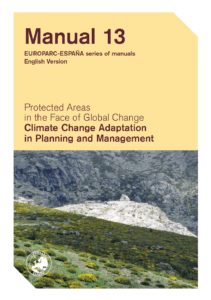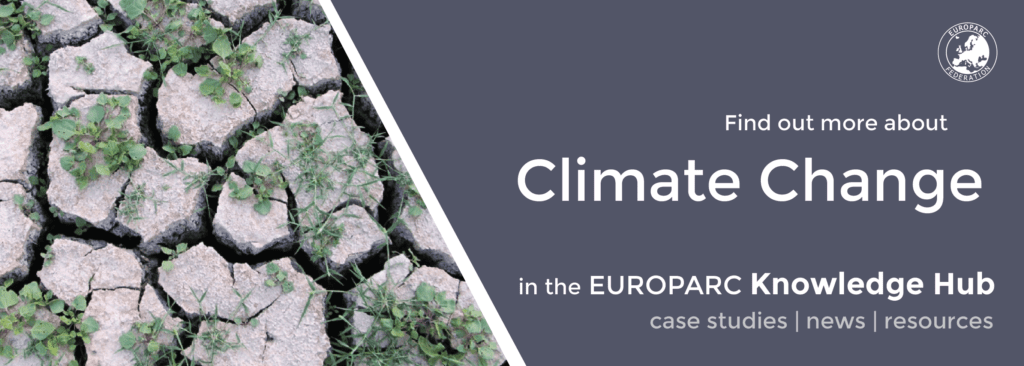A manual on climate change adaptation in protected areas
The manual on climate change adaptation in protected areas produced by EUROPARC Spain is now available in English.
Article by Olivier de Sadeleer, Project Manager – LIFE Natur’Adapt (Climate Change Adaptation)
We are proud to announce the release by EUROPARC-Spain of the English version of its leading-edge “Manual 13: Protected areas in the face of global change. Climate change adaptation in planning and management”.
While other drivers of change are well identified and routinely targeted by management plans (land-use changes, invasive species, or pollution), attention to climate change is still very low or often non-existent.
This is why the EUROPARC Federation and Sections are working to develop methods, tools and services that will enable managers to perform climate change vulnerability assessment and develop adaptation plans for nature protected areas.
Climate change creates even more uncertainty. It requires a new management approach. It pushes us to innovate.
said Marta Mugica, Coordinator of EUROPARC Spain, adding that “On top of keeping ecosystems in good conservation status, it is now important that we look into the future to ensure the greatest resilience possible.”
A manual on climate change adaptation in protected areas, for professionals!
Manual 13 aims at helping managers on the ground by offering guidance for major types of ecosystem. Although adaptation measures are context-specific, EUROPARC Spain compiled case studies and scientific references to build a state-of-the-art methodology to incorporate climate change adaptation measures in the design of management plans. Using this methodology, managers should be able to integrate climate change in the different phases of the planning process.
Useful links
Tracking large carnivores & tackling communication challenges
Bear and wolf photos from pixabay
Every year, the Alfred Toepfer Natural Heritage Scholarship supports the work of young conservationists in protected areas across Europe. László was one of the winners of the Scholarship in 2018. Applications for the Scholarship 2020 are now open! See how to apply here.
Article issued by László Patkó
Tracking large carnivores & tackling communication challenges
Estimated numbers of wolves (Canis lupus) and brown bears (Ursus arctos) in Europe are larger than 17.000 individuals and trends seem to continue increasing. Eurasian lynx (Lynx lynx) population estimation gives us a rough number of 9.000 individuals. After serious persecution of these species, the last decades were symbolized by a rapid recolonization into areas where their occurrence had fallen into oblivion. These landscapes have already been seriously altered by humans. There is, however, one common feature across the different European countries: carnivore return provokes opposite opinions in society.
During László’s scholarship, he focused on how people can coexist with large carnivores.
- clear scientific data (based on regular and reliable monitoring), and
- sensitization of stakeholders towards carnivores, as well as developing consensuses among stakeholders and conservation actors.
What are the right places to visit?
László Patkó’s study visit included four countries and five locations. László filmed interviews with local stakeholders and park employees. Explore his youtube channel:
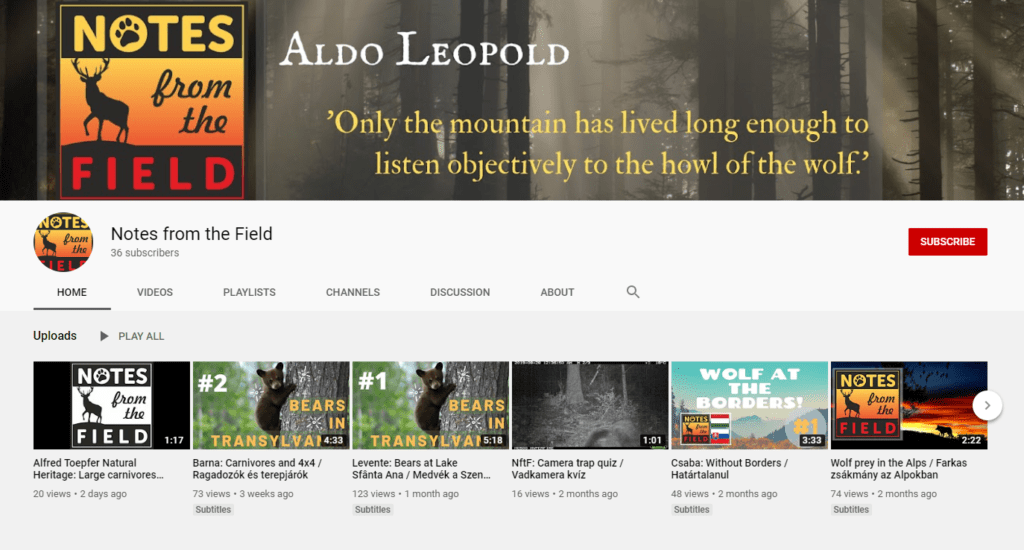
Check László´s youtube channel “Notes from the Field”
1) Italy: coexisting with wolves
The first location for a two-weeks-long period was the Alpi Marittime Nature Park in Italy. Here he learned about local involvement and coexisting with wolves. Shepherds seemed to be more open-minded towards carnivores than he previously anticipated. He had conversations on well-developed stakeholder engagement in the park with a communication expert and gathered knowledge on field and genetics monitoring, as well as wolves feeding habits from park rangers.
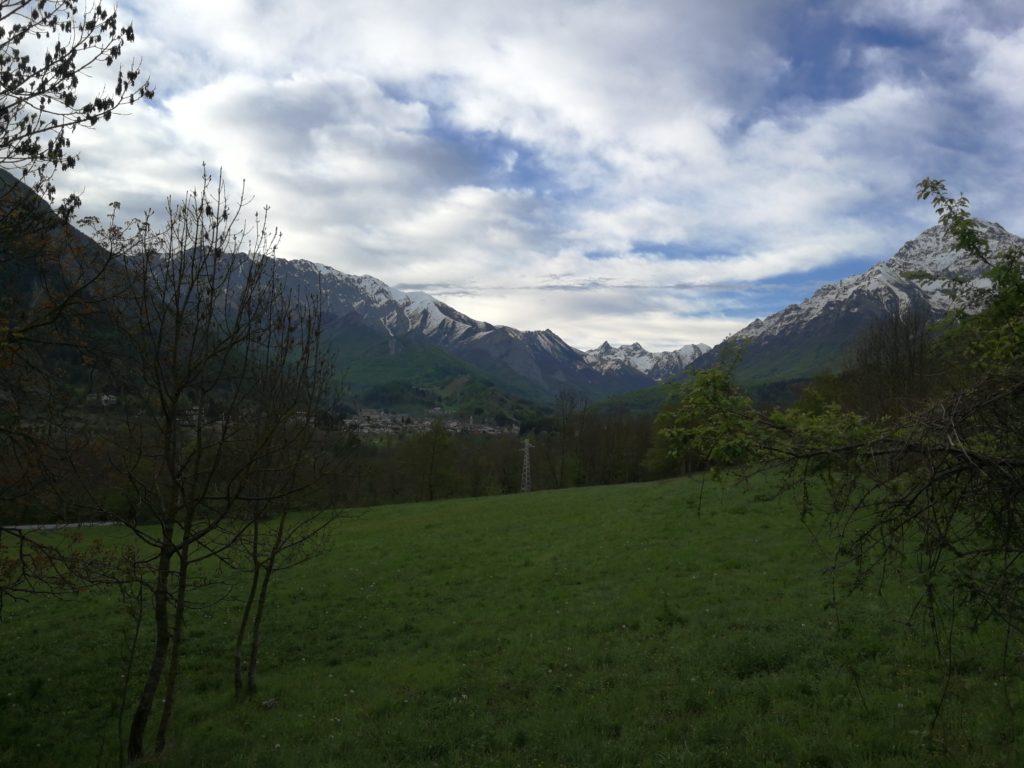
Wolf habitat in the Alpi Marittime Nature Park, Italy © László Patkó
2) Slovakia: monitoring bears
His next trip was to Cerová Vrchovina Landscape Protection Area. There, besides population monitoring, carnivore movement is also monitored with remote cameras between the Hungarian-Slovakian border. This is of high relevance in order to maintain the transboundary movements of large carnivores in the area. Another important topic in Slovakia is the game management and large carnivore conflict, which was highlighted by a hunter in the area.
At early Autumn László went to the Malá Fatra National Park where park employees have a long-standing data collection on bear presence. Here, together with local rangers, they were looking for potential bear den sites to install remote cameras for dens site monitoring.
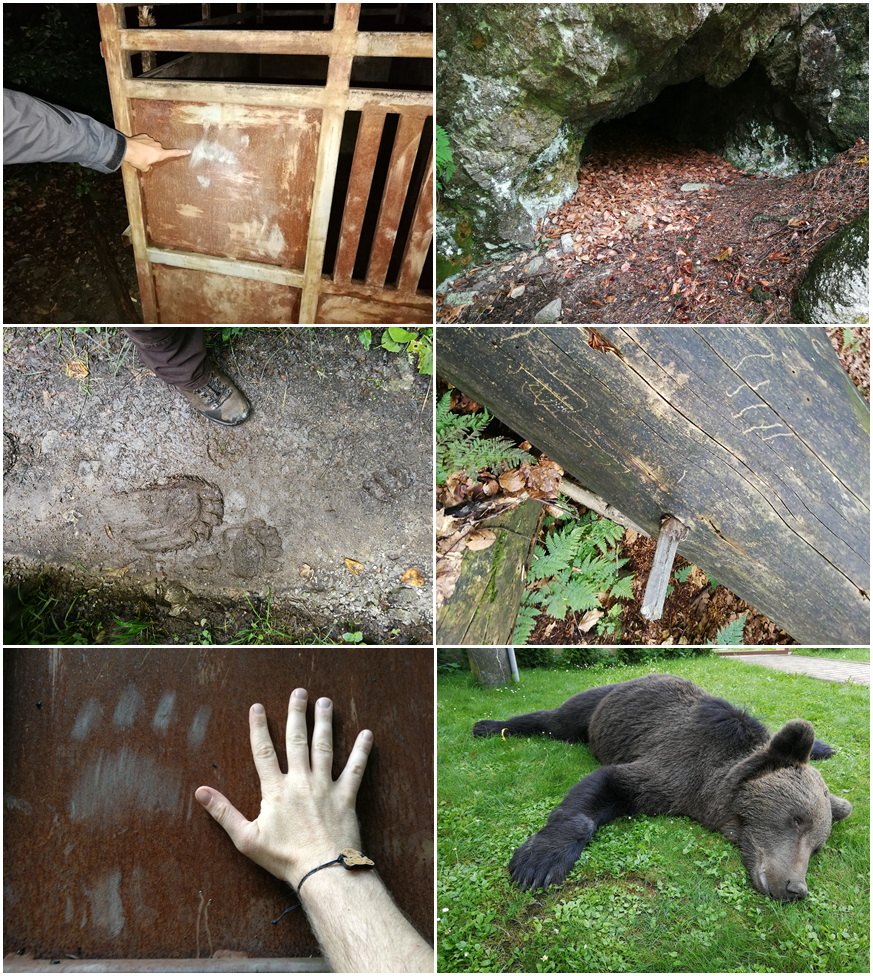
Proof of bear presence in the Mala Fatra National Park, Slovakia © László Patkó
3) Romania: mitigating conflicts with bears and the local population
László’s third destination was Cheile Bicazului-Hășmaș National Park in Transylvania, Romania. Approximately 40% of Europe’s brown bear population lives in Romania.
Romanian people have a long-standing relationship with bears, however nowadays national park employees and local wildlife face a new treat: quads and cross-country vehicles. Besides illegal driving in protected areas, Romania has a frequent conflict with habituated bears. These conflicts can be mitigated with using bear-proof bins and avoiding direct feeding of individuals, as László’s other interview partner highlighted it.
4) Hungary: participatory approaches
The last stop was Bükk National Park, where one of the two wolf populations can be found in Hungary. In these forests, migrant individuals of bears also occur every now and then. After a week-long study trip and discussions with national park personnel about the previous study trips, they came to the conclusion that countries shared one best practice: participative approach. With the help of the national park, WWF Hungary, the Sheep and Goat Breeders National Association and the Kuvasz Guard Association, the collaboration will organise a damage prevention conference for livestock breeders in Autumn, 2020.
Conclusions
László’s main finding was that we can only achieve a relatively peaceful coexistence with the help of various stakeholders. Based on the study trips the following points can ease the way into participatory approaches:
Deep understanding of different stakeholder groups. Take your time, grab a beer, start a campfire and have an honest discussion with whom you actually want to work with in the long run. Even if he or she has a different mindset from yours!
Personalizing more than one stakeholder can often help. Beside nature conservation, learn about hunters and shepherds. Even better: be one of them!
There is no such thing as “the” ranger, “the” hunter or “the” shepherd. There are people with their own agenda. Listen to them, understand them, work with them!
Find a common ground! The most controversial topics are often not the best for ice-breakers. There must be something you can work together with other stakeholders!
Establish a trust-based working environment with your stakeholders.
When you are done, you are not done. Regular communication with stakeholders is of key importance. Share your results, be transparent!
Download the full report: Tracking large carnivores and tackling communication problems
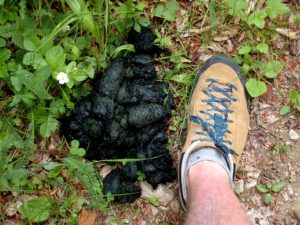
Cooperation seems to be “smelly” with people who don’t share your point of view, but this is the only way for truly coexist with each other © László Patkó
Watch the short film with the conclusions:
Bibliography
- “Notes from the Field” YouTube channel with more interviews:
- Kaczensky, P. et al. (2013) Status, management and distribution of large carnivores-bear, lynx, wolf and wolverine- in Europe. In: Report to the EU Commission, Part1.
- Chapron, G. et al. (2014) Recovery of large carnivores in Europe´s modern humandominated landscapes. Science 346(6216): 1517-1519
- Salvatori, V. et al. (2002) Hunting legislation in the Carpathian Mountains: implications for the conservation and management of large carnivores. Wildlife Biol 8(1): 3-10.
- Nowak, S., Myslajek, R. & Jedrzejewska, B. (2008) Density and demography of wolf,Canis lupus population in the western-most part of the Polish Carpathian Mountains, 1996-2003. Folia Zool 57(4): 392-402
- Chapron, G. & López-Bao, J. (2016) Coexistence with Large Carnivores Informed by Community Ecology. Trends Ecol Evol 31(8): 578-580
- Rigg, R. et al. (2011) Mitigating carnivore-livestock conflict in Europe: lessons from Slovakia. Oryx 45(2): 272-280
- Nelson, F. (2009) Developing payments for ecosystem services approaches to carnivore conservation. Hum Dim Wildlife 14(6): 381-392
- Letnic, M., Ritchie, E. & Dickman, C. (2012) Top predators as biodiversity regulators: the dingo Canis lupus dingo as a case study. Biol Rev 87: 390-413
- Ripple, W. et al. (2014) Status and ecological effects of the world’s largest carnivores. Science 343 (6167): 151-162
- Allen, B. et al. (2017) Can we save large carnivores without losing large carnivore science?. Food webs 12: 64-75
- Wilson, S. (2016) A guidebook to human-carnivore conflict: Strategies and tips for effective communication and collaboration with communities. Slovenia Forest Service – LIFE DINALP BEAR project, Ljubljana, Slovenia. 60 pp.23
- Wallach, A. et al. (2010) Predator control promotes invasive dominated ecological states. Ecol Lett 13: 1008-1018.
- van Bommel, L. & Johnson, C. (2012) Good dog! Using livestock guardian dogs to protect livestock from predators in Australia´s extensive grazing systems. Wildlife Res 39: 220-229
- Prugh, L. et al. (2009) The rise of the mesopredator. Bioscience 59(9): 779-790
- Wagner, K., Schmidt, R. & Conover, M. (1997) Compensation programs for wildlife damage in North America. Wildlife Soc B 25(2): 312-319.
- Nilsen, E. et al. (2007) Wolf reintroduction to Scotland: public attitudes and consequences for red deer management. Proc R Soc B 274: 995-1002
- Burbaité, L. & Csányi, S. (2010) Red Deer population and harvest changes in Europe. Act Zool Lit 20 (4); 179-188
- Ripple, W. & Beschta, R. (2012) Large predators limit herbivore densities in northern forest ecosystems. Eur J Wildl Res 58: 733-742
- Nowak, S., Myslajek, R. & Jedrzejewska, B. (2005) Patterns of wolf Canis lupus predation on wild and domestic ungulates in the Western Carpathian Mountains (S Poland). Acta Theriol 50(2): 263-276
- Betschta, R. & Ripple, W. (2009) Large predators and trophic cascades in terrestrial ecosystems of the western United States. Biol Conserv 142: 2401-2414
- Hebblewhite, M. et al. (2005) Human activity mediates a trophic cascade caused by wolves. Ecol 86(8): 2135-2144
- Betscha, R. & Ripple, W. (2012) The role of large predators in maintaining riparian plant communities and river morphology. Geomorphology 157-158: 88-98
- Estes, J. et al (2011) Trophic downgrading of planet Earth. Science 333: 301-306
- Schmitz, O. et al. (2013) Animating the carbon cycle. Ecosystems 10; 1-16
- Wilmers, C. et al. (2003) Trophic facilitation by introduced top predators: grey wolf subsidies to scavengers in Yellowstone National Park. J Anim Ecol 72: 909-91624
- Beekers, B. et al. (2017) Circle of life: A new way to support Europe’s scavengers. ARK Nature and Rewilding Europe. 28pp.
Celebrating 50 Years of Earth Day
The president of the EUROPARC Federation calls for people to listen to our natural heritage – not stock market listings.
Article issued by Ignace Schops,
Today we celebrate 50 years of Earth Day.
It seems like there is not a lot to celebrate, or is there?
The Coronavirus has obliged us to look at the wider picture of how our society functions. Our politicians have relied on scientific knowledge and recommendations to solve this crisis. The draconian measures deemed impossible until recently, have become a reality today. The impossible suddenly becomes possible.
Can we count on similar leadership and the same methods for saving Mother Earth and ourselves? Because we’ve made a mess of things over the last 50 years! With currently 7.8 billion people, the world’s population has doubled, the cultivated area on a global scale has increased by 22 million hectares, 230 million hectares of grassland have been added for cattle, and on top of that, an additional 160 million hectares for arable land.
All this extra space has been taken from our natural heritage.
We have been blind to the collapsing natural ecosystems that keeps our climate stable and provides us with healthy air and drinkable water. We did not listen to the deafening last words of so many life forms on earth. There has certainly been no stock market listing, nor value for a share of nature.
There are consequences arising from our actions. One example. In many parts of Europe we have experienced weather conditions like it was already summer: warm and almost no rain! Despite a drenched spring, the groundwater reserves are dwindling like snow in the sun. Without rain and with high temperatures, the drought increases at an infernal rate. Because of the dehydration, the soil has become concrete in many places where a bird’s beak can’t get through and where toads and frogs croak no more. Farmers already have to pump a huge amount of water, just to keep the crops alive, which only aggravates the situation.
The consequences of an overpopulated world are overwhelming. Each person on this planet now emits on average 21% more CO2 than 50 years ago and we all emit 47% more! These are the averages, but you need to know that only 10% of the world’s population is responsible for 50% of emissions. Per capita, we use 47 times more fossil fuels, consume 65% more meat, produce 447% more plastic and our air travel has increased by 561%! Extreme weather conditions such as hurricanes, floods and extreme drought increased by 44% between 1980 and 2018.
So it would seem, there is no good news at all to report.
But there is.
The reset, the necessary sustainable transformation is slowly underway.
The average number of births per woman dropped from 4.5 in 1970 to 2.2 now and 86% of the world’s population now has access to basic education. The volume of solar energy has increased 400 times, 3.2 million square kilometers of forests have been restored and 27 million square kilometers of marine nature have been protected.
But we are not there yet!
If we don’t halve the CO2 emissions in the next decade and prevent the collapse of natural ecosystems, things will go wrong for our society.
We need everyone now to turn the tide. Let us learn from these past 50 years and celebrate our hope and ambition for a new future.
Ignace Schops
President of the EUROPARC Federation
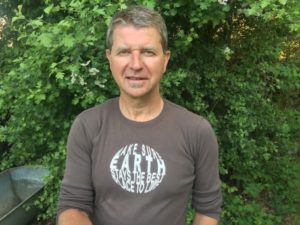
[webinar] Climate Change in Protected Areas: Strengths, Weaknesses, Opportunities and Threats
Climate is changing. Shouldn’t nature conservation adapt and rise to the challenge? This is the second episode of a webinar series on climate change adaptation and protected area management that aims to help protected area managers answer this question.
Strengths, Weaknesses, Opportunities and Threats: understanding the situation of nature conservation and European protected areas in a changing climate
- 28 of April 2020
- 10:00 CET (Central Europe Time)
- Registration is needed (webinar it’s open and free 🙂 ) https://webinarclimatechangeswot.gr8.com/
You might have seen a SWOT analysis applied in many contexts, but have you seen it applied to climate change? On the 28th of April, we invite you to look at the Strengths, Weaknesses, Opportunities and Threats of European Protected Areas in a changing climate.
In this second episode of our Webinar series on climate change (see the results of the first webinar here) you will hear the outcomes of the recent work done by the EUROPARC Climate Change Task Force, a key component of the LIFE Natur’Adapt project. Besides sharing best practice, the expert group is developing tools for Protected Area managers to support their efforts of conserving Nature in Europe by improving their interactions (and collaborations) with political decision-makers and governing bodies.
Programme:
1) Introduction and Outcomes of the Digital Siggen Seminar, by Olivier de Sadeleer, EUROPARC Federation, Belgium
2) Why a SWOT analysis? Elements of context, by Anne-Cerise Tissot, Réserve Naturelles de France, France
3) Understanding the Strengths and Weaknesses of European nature conservation and protected areas in the face of climate change, by Stewart Pritchard, Scottish Natural Heritage, Scotland, UK
4) Understanding the Opportunities and Threats to European nature conservation and protected areas in the face of climate change, by Myrthe Fonck, Puur Water and Natuur, The Netherlands
About NaturAdapt
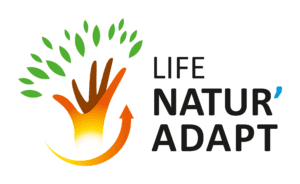
In Europe, Réserves Naturelles de France, EUROPARC and eight partners have joined forces under a LIFE Climate Action project to turn the climate change adaptation challenge into an opportunity to innovate for nature conservation. NaturAdapt aims to initiate a transition towards adaptive management of protected areas while laying the foundation for a dynamic collective learning process.
If you wish to know more about the project, a brief description is available here.
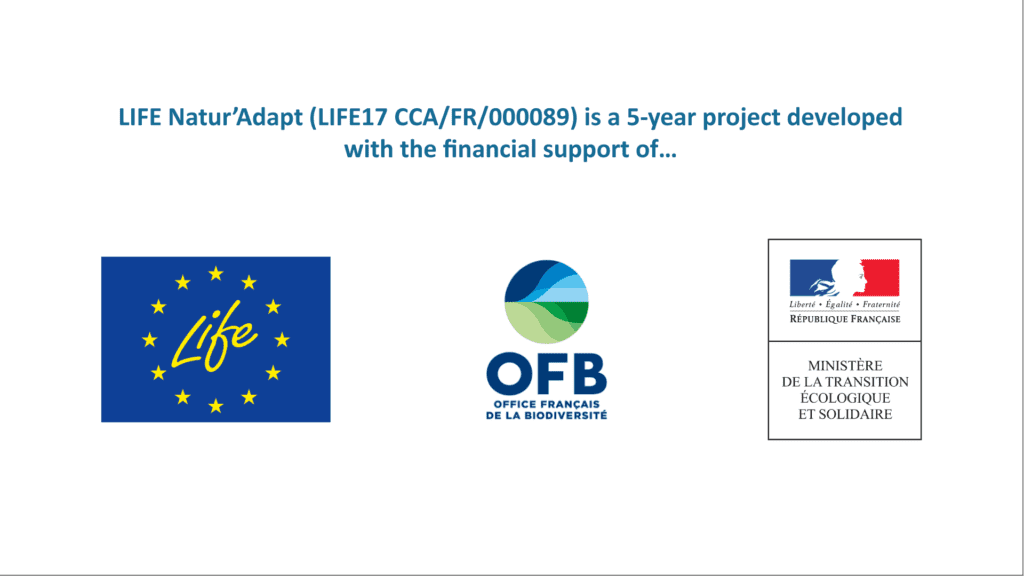
Find more resources on climate change
